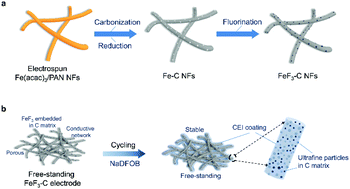A nanoconfined iron(iii) fluoride cathode in a NaDFOB electrolyte: towards high-performance sodium-ion batteries†
Abstract
Iron(III) fluoride (FeF3) is considered a potential cathode for sodium-ion batteries (SIBs) due to its high capacity and low cost. However, particle pulverization upon cycling generally results in rapid degradation of its structure and capacity. Here, we introduce a free-standing nanoconfined FeF3 cathode and a novel electrolyte salt, sodium-difluoro(oxalato)borate (NaDFOB), for SIBs. The assembled cells show a high discharge capacity up to ∼230 mA h g−1 at a rate of 20 mA g−1 (∼200 mA h g−1 at 100 mA g−1) and a capacity retention up to ∼70% after 100 cycles, which represent the best results reported for FeF3 in Na-ion electrolytes. The achieved high performance can be attributed to the synergic protection provided by the nanoconfined FeF3 electrode and the NaDFOB electrolyte. Post-mortem analysis and quantum mechanics show that DFOB anions facilitated the formation of a thin cathode electrolyte interphase (CEI) on the surface of FeF3-carbon nanofibers (CNFs) via oligomerization.



 Please wait while we load your content...
Please wait while we load your content...